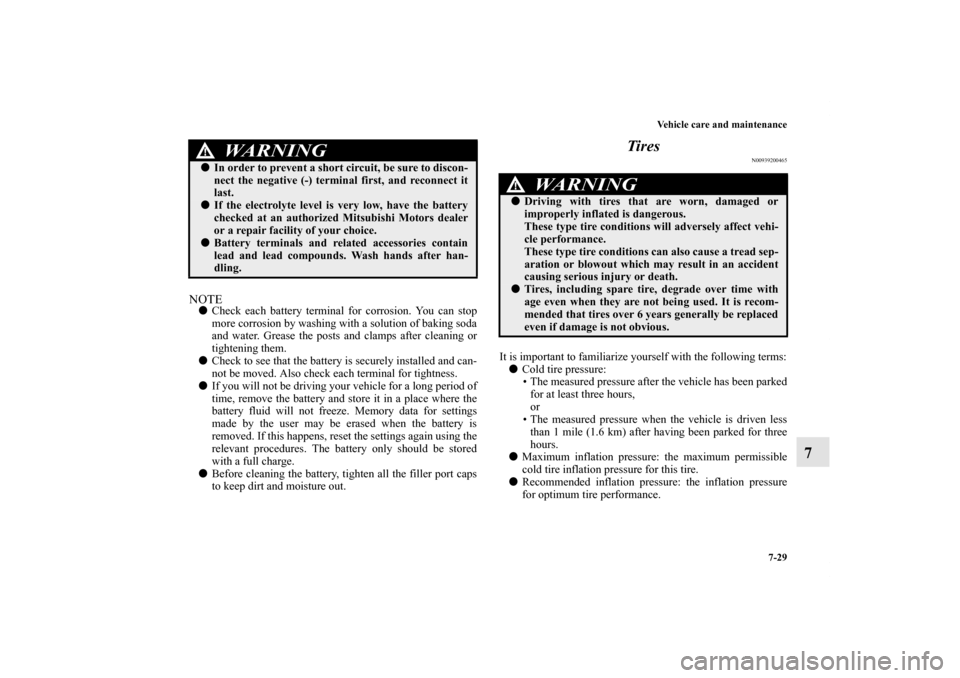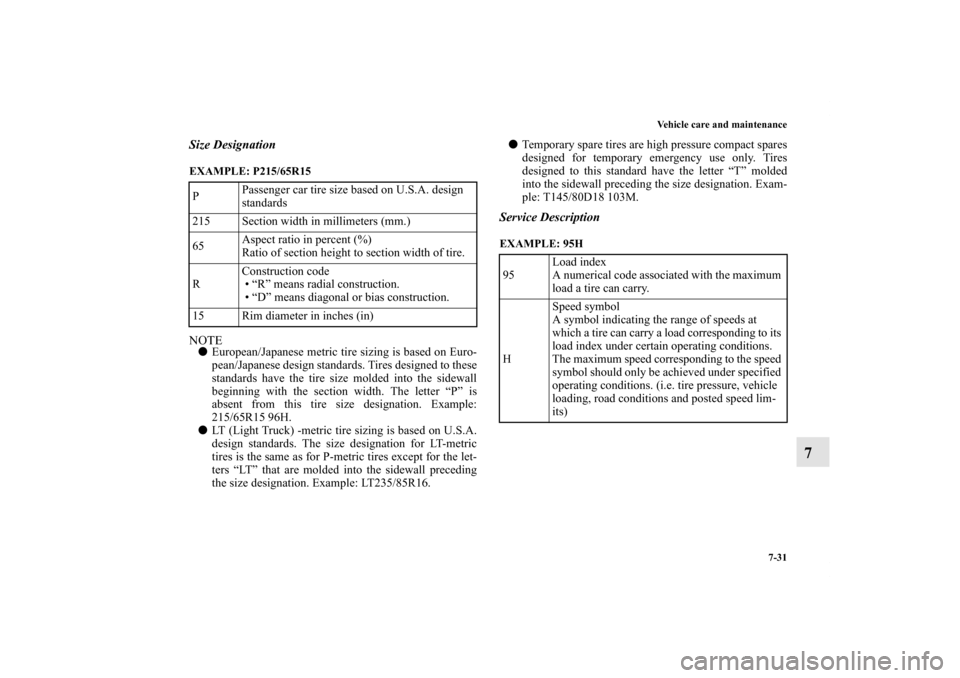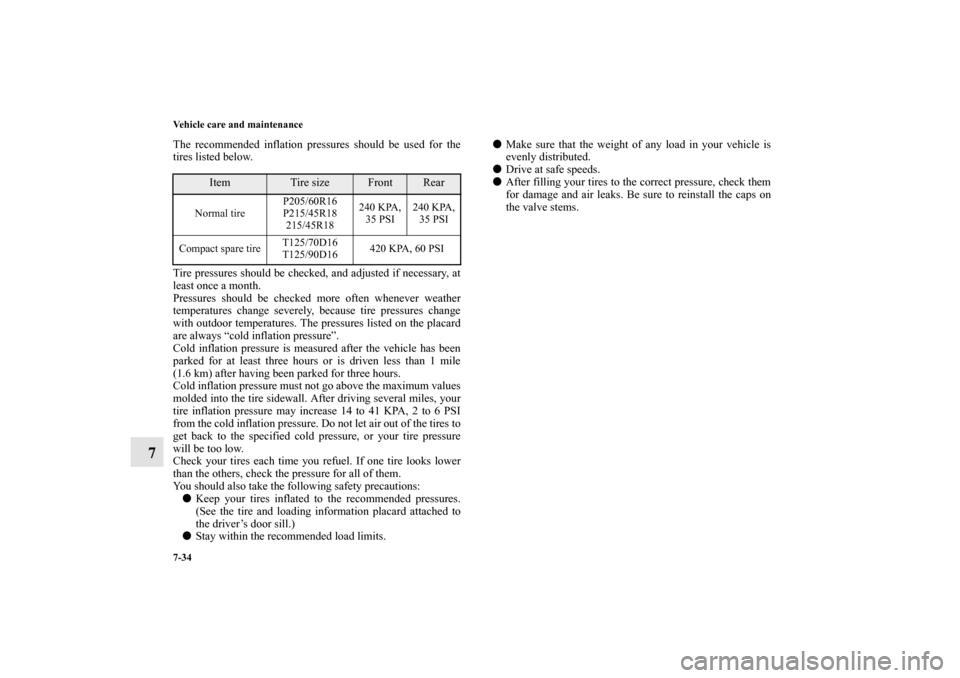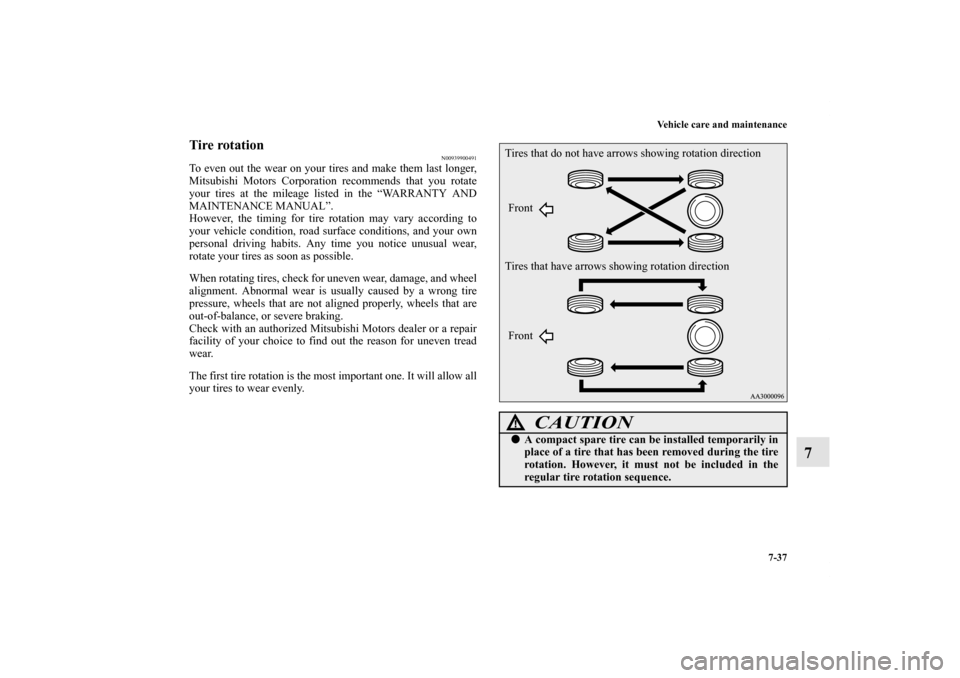Page 608 of 706

Vehicle care and maintenance
7-29
7
NOTE�Check each battery terminal for corrosion. You can stop
more corrosion by washing with a solution of baking soda
and water. Grease the posts and clamps after cleaning or
tightening them.
�Check to see that the battery is securely installed and can-
not be moved. Also check each terminal for tightness.
�If you will not be driving your vehicle for a long period of
time, remove the battery and store it in a place where the
battery fluid will not freeze. Memory data for settings
made by the user may be erased when the battery is
removed. If this happens, reset the settings again using the
relevant procedures. The battery only should be stored
with a full charge.
�Before cleaning the battery, tighten all the filler port caps
to keep dirt and moisture out.
Tires
N00939200465
It is important to familiarize yourself with the following terms:
�Cold tire pressure:
• The measured pressure after the vehicle has been parked
for at least three hours,
or
• The measured pressure when the vehicle is driven less
than 1 mile (1.6 km) after having been parked for three
hours.
�Maximum inflation pressure: the maximum permissible
cold tire inflation pressure for this tire.
�Recommended inflation pressure: the inflation pressure
for optimum tire performance.
�In order to prevent a short circuit, be sure to discon-
nect the negative (-) terminal first, and reconnect it
last.�If the electrolyte level is very low, have the battery
checked at an authorized Mitsubishi Motors dealer
or a repair facility of your choice.�Battery terminals and related accessories contain
lead and lead compounds. Wash hands after han-
dling.
WA R N I N G
!
WA R N I N G
!�Driving with tires that are worn, damaged or
improperly inflated is dangerous.
These type tire conditions will adversely affect vehi-
cle performance.
These type tire conditions can also cause a tread sep-
aration or blowout which may result in an accident
causing serious injury or death.�Tires, including spare tire, degrade over time with
age even when they are not being used. It is recom-
mended that tires over 6 years generally be replaced
even if damage is not obvious.
BK0125300US.book 29 ページ 2010年5月18日 火曜日 午後1時53分
Page 610 of 706

Vehicle care and maintenance
7-31
7
Size DesignationEXAMPLE: P215/65R15
NOTE�European/Japanese metric tire sizing is based on Euro-
pean/Japanese design standards. Tires designed to these
standards have the tire size molded into the sidewall
beginning with the section width. The letter “P” is
absent from this tire size designation. Example:
215/65R15 96H.
�LT (Light Truck) -metric tire sizing is based on U.S.A.
design standards. The size designation for LT-metric
tires is the same as for P-metric tires except for the let-
ters “LT” that are molded into the sidewall preceding
the size designation. Example: LT235/85R16.�Temporary spare tires are high pressure compact spares
designed for temporary emergency use only. Tires
designed to this standard have the letter “T” molded
into the sidewall preceding the size designation. Exam-
ple: T145/80D18 103M.
Service DescriptionEXAMPLE: 95H
PPassenger car tire size based on U.S.A. design
standards
215 Section width in millimeters (mm.)
65Aspect ratio in percent (%)
Ratio of section height to section width of tire.
RConstruction code
• “R” means radial construction.
• “D” means diagonal or bias construction.
15 Rim diameter in inches (in)
95Load index
A numerical code associated with the maximum
load a tire can carry.
HSpeed symbol
A symbol indicating the range of speeds at
which a tire can carry a load corresponding to its
load index under certain operating conditions.
The maximum speed corresponding to the speed
symbol should only be achieved under specified
operating conditions. (i.e. tire pressure, vehicle
loading, road conditions and posted speed lim-
its)
BK0125300US.book 31 ページ 2010年5月18日 火曜日 午後1時53分
Page 613 of 706

7-34 Vehicle care and maintenance
7
The recommended inflation pressures should be used for the
tires listed below.
Tire pressures should be checked, and adjusted if necessary, at
least once a month.
Pressures should be checked more often whenever weather
temperatures change severely, because tire pressures change
with outdoor temperatures. The pressures listed on the placard
are always “cold inflation pressure”.
Cold inflation pressure is measured after the vehicle has been
parked for at least three hours or is driven less than 1 mile
(1.6 km) after having been parked for three hours.
Cold inflation pressure must not go above the maximum values
molded into the tire sidewall. After driving several miles, your
tire inflation pressure may increase 14 to 41 KPA, 2 to 6 PSI
from the cold inflation pressure. Do not let air out of the tires to
get back to the specified cold pressure, or your tire pressure
will be too low.
Check your tires each time you refuel. If one tire looks lower
than the others, check the pressure for all of them.
You should also take the following safety precautions:
�Keep your tires inflated to the recommended pressures.
(See the tire and loading information placard attached to
the driver’s door sill.)
�Stay within the recommended load limits.�Make sure that the weight of any load in your vehicle is
evenly distributed.
�Drive at safe speeds.
�After filling your tires to the correct pressure, check them
for damage and air leaks. Be sure to reinstall the caps on
the valve stems.
Item
Tire size
Front
Rear
Normal tireP205/60R16
P215/45R18
215/45R18240 KPA,
35 PSI240 KPA,
35 PSI
Compact spare tire T125/70D16
T125/90D16420 KPA, 60 PSI
BK0125300US.book 34 ページ 2010年5月18日 火曜日 午後1時53分
Page 616 of 706

Vehicle care and maintenance
7-37
7
Tire rotation
N00939900491
To even out the wear on your tires and make them last longer,
Mitsubishi Motors Corporation recommends that you rotate
your tires at the mileage listed in the “WARRANTY AND
MAINTENANCE MANUAL”.
However, the timing for tire rotation may vary according to
your vehicle condition, road surface conditions, and your own
personal driving habits. Any time you notice unusual wear,
rotate your tires as soon as possible.
When rotating tires, check for uneven wear, damage, and wheel
alignment. Abnormal wear is usually caused by a wrong tire
pressure, wheels that are not aligned properly, wheels that are
out-of-balance, or severe braking.
Check with an authorized Mitsubishi Motors dealer or a repair
facility of your choice to find out the reason for uneven tread
wear.
The first tire rotation is the most important one. It will allow all
your tires to wear evenly.
CAUTION
!�A compact spare tire can be installed temporarily in
place of a tire that has been removed during the tire
rotation. However, it must not be included in the
regular tire rotation sequence.Tires that do not have arrows showing rotation direction
Tires that have arrows showing rotation directionFront
Front
BK0125300US.book 37 ページ 2010年5月18日 火曜日 午後1時53分
Page:
< prev 1-8 9-16 17-24